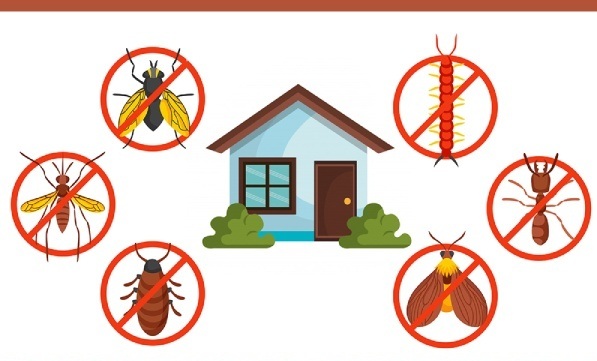IPM is an ecosystem-based strategy focusing on long-term prevention of pests or their damage through a combination of techniques such as biological control, habitat manipulation, modification of cultural practices, and the use of resistant varieties. By addressing root causes while minimizing toxic chemical usage, IPM aims for sustainable pest management without harmful side effects on people and the environment.
Implementing IPM in Construction
Real-life examples like the University of Minnesota’s intervention in a high-risk apartment community for elderly residents demonstrate IPM’s effectiveness. Emphasizing proactive communication between tenants, property managers, pest control technicians, and university experts led to a significant reduction in bed bug infestations.
Building Design Considerations
Proper moisture control plays a crucial role in preventing pest problems. Architects should ensure adequate ventilation, install vapor barriers against moisture seepage, and select mold-resistant materials for building constructions.
Material Selection for Resistance
Using bed bug-resistant materials such as metal or thick plastic furniture is beneficial. Incorporating controlled gaps between wall layers also assists with early detection by allowing for easier visual inspections.
Preventative Inspections & Monitoring
Routine inspections and monitoring are essential components of IPM programs for bed bugs. Visual inspections target areas where people sleep like beds are necessary for early identification and resolution. Installing interception devices can help trap any bugs attempting to access furniture.
Early Detection and Response
A swift response is crucial in preventing bed bugs from spreading further. Establishing protocols involving professional treatment services, tenant education, and communication strategies is essential for effective control efforts.
Effective Control Methods
Selecting the ideal approach for managing bed bugs requires considering aspects like the extent of infestation, individual reactions to pesticides, budgetary constraints, and ease of access to the affected location. Integrated Pest Management (IPM) emphasizes reducing or eradicating the application of pesticides wherever feasible. By carefully evaluating these factors, bed bug removal services can provide an effective solution tailored to individual needs and preferences.
Education and Communication Efforts
Ensuring all parties involved understand their responsibilities related to pest prevention contributes to successful IPM programs. Education about detecting and reporting pests allows for better long-term outcomes.
Evaluating IPM Success
Measuring an IPM program’s effectiveness involves assessing various factors like reductions in bed bug infestations, tenant satisfaction levels with preventative measures, pesticide usage statistics, and overall cost-efficiency.
Shared Responsibility in Pest Management
Eradicating bed bugs requires the collective efforts of all stakeholders involved in creating and maintaining a pest-free environment. Architects, builders, property managers, exterminators, and tenants must cooperate to prevent pest infestations from affecting the community. By incorporating IPM strategies into construction projects and renovation plans proactively, stakeholders reinforce shared responsibilities for sustainable outcomes.
Continuous Improvement in IPM Practices
As our understanding of bed bugs and their behaviors evolves, so should the pest management practices employed to combat them. This involves ongoing research into new techniques, materials, and strategies that can be adopted within an IPM framework. By actively participating in industry conferences, workshops, or online forums focused on IPM topics in construction and building management, professionals can stay updated on emerging trends and best practices.
Moreover, engaging with local authorities or other organizations responsible for pest regulations helps ensure adherence to recommended guidelines. In doing so, architects and property managers can not only provide optimal living conditions for occupants but also remain compliant with any legal requirements stipulated by various governing bodies.
Ultimately, addressing bed bug infestations requires continuous commitment and dedication from all parties involved. Implementing integrated pest management principles necessitates a long-term focus on education and communication among tenants, staff, management teams, and third-party service providers to create an overarching culture of prevention and control.
Promoting IPM Awareness and Advocacy
In addition to implementing IPM strategies within individual buildings, there is an opportunity for industry professionals and tenants to advocate for broader awareness of integrated pest management principles. This can be achieved by collaborating with local community organizations, environmental groups, and even educational institutions to spread knowledge about bed bug prevention, early detection, and control methods.
Hosting informational sessions on the benefits of adopting IPM approaches or organizing workshops on specific best practices tailored to different stakeholder groups can contribute significantly to creating a more bed bug-aware society. By supporting public campaigns that promote responsible pest management actions beyond one’s immediate surroundings, architects and property managers play a crucial role in raising the overall quality of urban living.
In summary
Investing time and resources into implementing robust IPM programs delivers far-reaching positive impacts to residential buildings while significantly reducing the risk of ongoing bed bug problems. It’s essential for architects working in urban environments to recognize the value of well-designed buildings equipped with successful pest management plans – practically ensuring occupants a comfortable home environment where they feel safe knowing unwelcome pests are being kept at bay by proven strategies that strike a balance between effectiveness and environmental responsibility.



